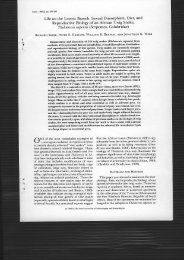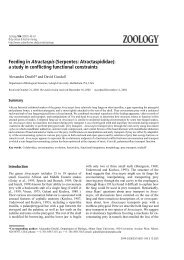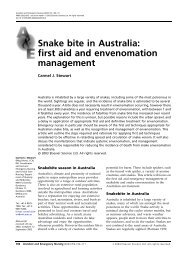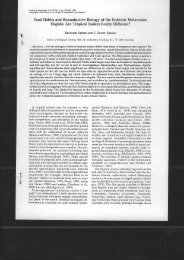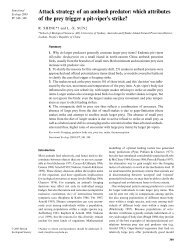Introduction - Kingsnake.com
Introduction - Kingsnake.com
Introduction - Kingsnake.com
Create successful ePaper yourself
Turn your PDF publications into a flip-book with our unique Google optimized e-Paper software.
Clinical Management of Snakebite in Papua New Guinea Chapter 2<br />
Differences between non-venomous and venomous snakes<br />
The accepted means of distinguishing one species of snake from another has for many years<br />
been based upon counting the numbers and arrangements of scales on their bodies (FIGURES 1<br />
& 2). This works very well for zoologists and museum technicians, but unfortunately is<br />
fraught with obvious dangers for everyone else. As a consequence it is very difficult for<br />
untrained people to identify one snake from another, and this has special significance when<br />
dealing with cases of snakebite.<br />
In southern PNG the vast majority of snakebite victims who see a snake identify the offending<br />
animal as a ‘Pap black’; literally taken to mean a Papuan blacksnake (Pseudechis papuanus).<br />
Accepting such an identification at close quarters can, however, have disastrous<br />
consequences, given that:<br />
(a) there are several species of snakes (assuming a snake is actually involved at all) that<br />
may have been responsible for the snakebite; and while,<br />
(b) some of them are <strong>com</strong>pletely non-venomous species, at least two species of blackcoloured<br />
snake are extremely venomous; and<br />
(c) administration of the either the incorrect antivenom, or an antivenom when one is not<br />
required can result in serious medical <strong>com</strong>plications or the death of the patient.<br />
Studies of snakebite in Papua New Guinea have demonstrated that the reality is that less than<br />
5% of serious snakebites admitted to PMGH are caused by Papuan blacksnakes (Pseudechis<br />
papuanus), and that an overwhelming majority (83.2%) of ‘Pap black’ bites are actually<br />
caused by the much more dangerous Papuan taipan (Oxyuranus scutellatus canni).<br />
FIGURE 1: IDENTIFICATION FEATURES OF SNAKES: HEAD SCALATION<br />
Typical arrangement of head scales that are used in the identification of different species<br />
of snakes. KEY: (ACH) anterior chin shield; (AT) anterior temporals; (F) frontal; (GF) gular<br />
fold; (IL) infralabials; (IN) internasal; (LF) lingual fossa; (M) mental; (N) nasal; (P) parietal;<br />
(PCH) posterior chin shield; (PF) prefrontal; (PoO) postoculars; (PrO) preoculars; (PT)<br />
posterior temporals; (R) rostral; (SL) supralabials; (SO) supraocular; (V) ventrals.<br />
SOURCE: A Guide to the Snakes of Papua New Guinea by M T O’Shea (Independent Publishing) (1996)<br />
- 2.7 -




